Understanding the Sleeve Part 3: The Triangle & Bicep/Cap Height Relationship
There are four parts to this article on Understanding the Sleeve and they follow on from each other . In order to get a well-fitting sleeve, you need to get the measurements of the triangle which underpins the curve correct. So let's strip away the curve and look at just the triangle. Since it's a triangle, there are of course three sides, but the height of the triangle - called the Cap Height, also plays a part. This triangle can be constructed with 2 out of 3 measurements - the armhole, bicep and cap height - as shown in Figure 1. One of the 3 measurements will be the result of the other two.
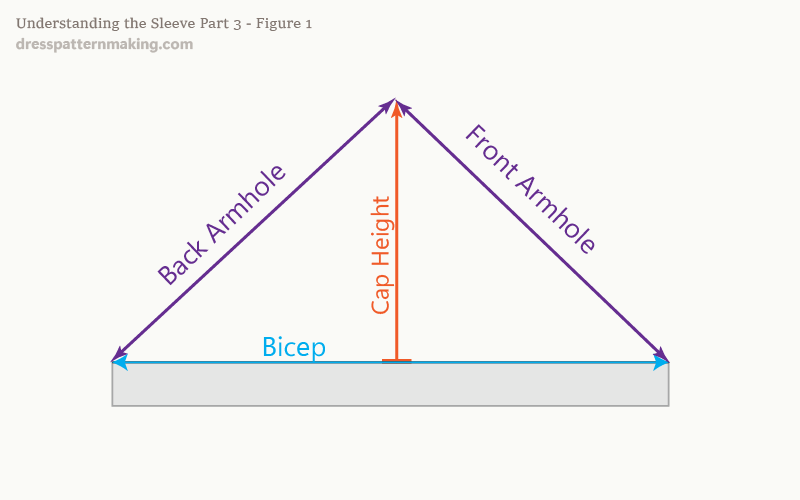
The Front & Back Armhole Measurements
When creating a sleeve, we make it to fit a Bodice Block. The sleeve you would be making on this website is to fit the Bodice Block you have made. you can therefore measure the back and front armholes, and plug this measurement into the triangle above to make the sleeve. In order to get the extra ease you need in the sleeve cap, you also need to add 0.25-inches to both the back and front armhole measurements. This ease that is added to the straight lines, plus the additional length that is added by the curve that is built around this straight line, ends up giving us the ease we need to sew the sleeve cap onto the armhole. This ease is usually between 1.25-1.75-inches. This means the sleeve cap curve measures 1.25 - 1.75-inches more than the front and back armholes added together. So looking at the triangle again and applying basic math, it should be obvious that (given we have the armhole measurements, and we want to use those measurements) we can either set the Bicep measurement or the Cap Height. If we set both the Bicep and the Cap Height, we may end up incorrect measurements for the back and front armhole. If this is not obvious to you, there are some images below to clarify it.
Examples: Cap Height/Bicep Relationship
If we change the Bicep - for example, increase it by 1 inch, and we leave the Cap Height the same, we will be increasing the armhole measurements, as shown inb Figure 2.
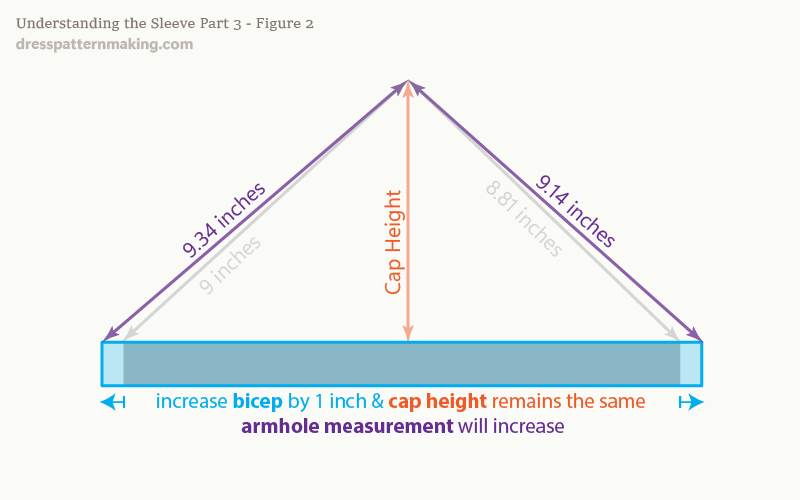
If we increase the Bicep while leaving the armhole measurements unchanged, the Cap Height will be reduced.
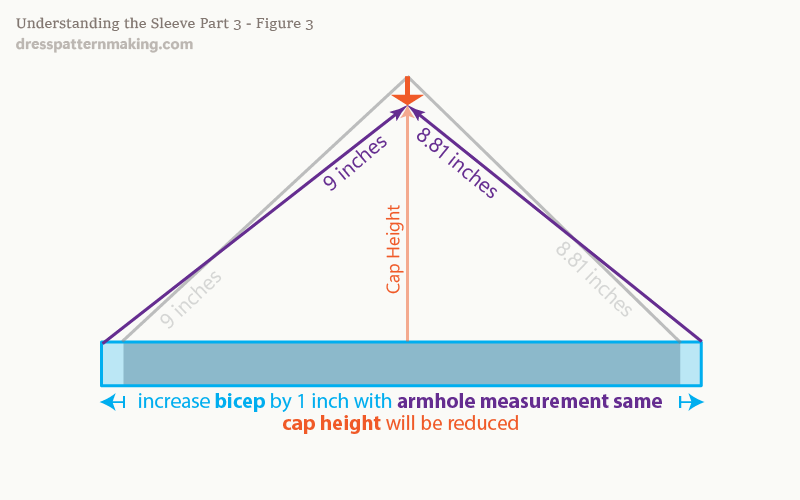
Changing the CapHeight - for example, increasing it by 1 inch and leaving the bicep the same, the armhole measurements will need to be increased, as seen in Figure 4.
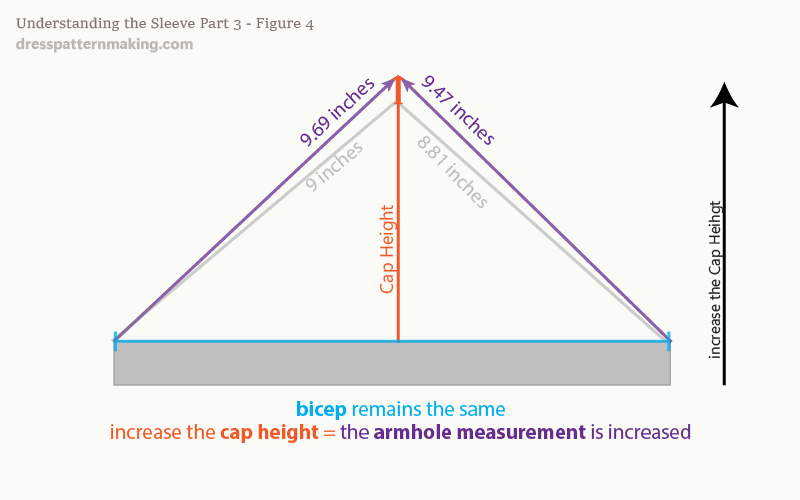
So what does this mean? Bicep or Cap Height?
It just so happens that with the Standard Figure, that the Bicep/Cap Height relationship works out well. Meaning that if you set the Cap Height, you end up with the correct bicep measurement (including 2 inches ease). If you set the Bicep, you end up with the correct Cap Height. This ideal relationship between the two means your armhole measurements remain correct,and you end up with the ideal fitted sleeve block. The ideal fitted sleeve block is minimal ease in the sleeve cap and minimal ease in the bicep. If you don't have a standard figure, and by that I mean:
- your bicep is proportionally larger for your size
- you need more ease in the bicep than 2-inches*
then the (bad?) news is that in your case, the ideal Fitted Sleeve is not quite so easy.
Bicep & Cap Height: The Problem
The ease that is added to the bicep isn't just ease for the bicep. It also includes ease for the upper arm. If you have larger than normal upper arms, and/or forwards sloping shoulders (and maybe other fitting issues), you may need up to 4-inches ease at your bicep level. The contradiction here is: if I need 4 inches ease in the bicep to make the sleeve wearable, that really is still minimal wearing ease. However, for a Fitted Sleeve Block, adding 4 inches ease to the bicep, and using your actual Cap Height means you will probably end up having excess ease in the Sleeve Cap. Either way you don't have the IDEAL amount of minimum ease.
Example
In Figure 6 below, the white sleeve is made with my bicep measurement (plus 2 inches ease) and my cap height measurement. The result is a sleeve with minimal ease in the bicep and minimal ease in the sleeve cap. If I stand with my hands by my side it seems to fit; there is enough ease in the bicep for the actual bicep. However, when I reach my arms forward it pulls from the mid back of the sleeve to the front armhole side seam point. The constriction borders on painful, but at the minimum is extremely uncomfortable. There isn't enough ease for my upper arm to reach forward, and in order to fix this, I need to add extra ease to the bicep. If I increase the bicep ease to 4-inches, I get some extra ease in the place where it pulls; this sleeve will make a comfortable sleeve that I can wear. It also has the minimum amount of ease in the sleeve cap, so there won't be gathers and tucks in the sleeve cap. However, it's not using my Cap Height and it flares out a bit from the arm instead of following the contours. Is it still a fitted sleeve? Well, that's the question..... how fitted does a Fitted Sleeve have to be to be a Fitted Sleeve?
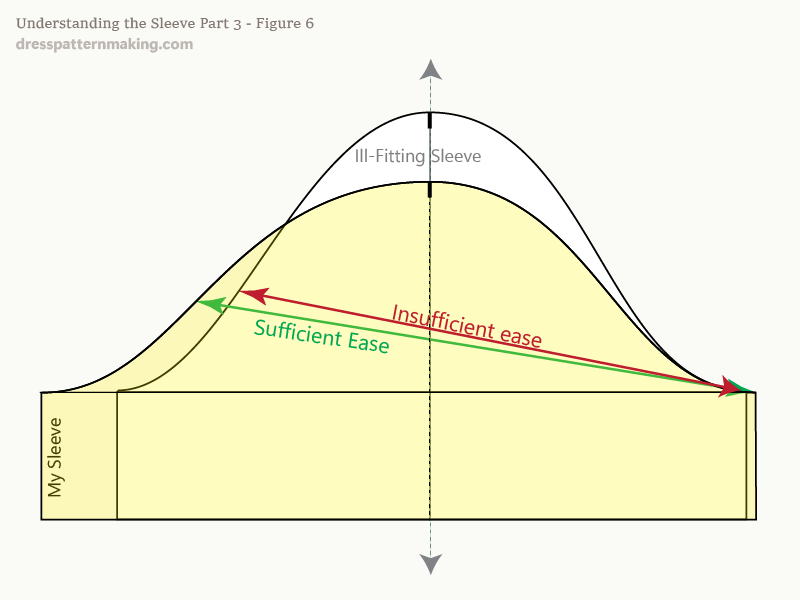
In image 7, I have the 4-inches ease in the Bicep AND kept my Cap Height. As you can see, I have even more ease for my forward-stretch, but my sleeve cap has now increased by 2-inches. That is 2-inches more than the minimum amount needed to sew the sleeve into the armhole.
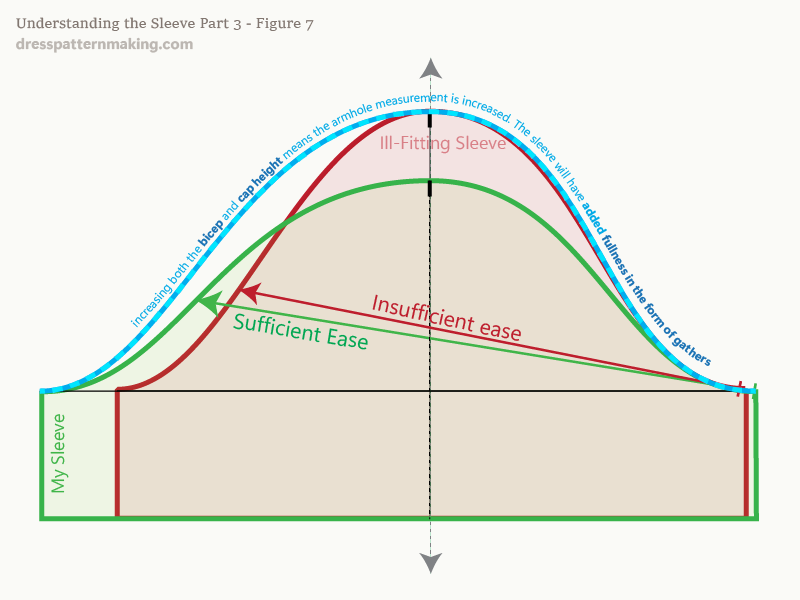
In this case my options are:
- live with the some gathers in the sleeve cap. (Do I care I can't have the ideal fitted sleeve cap?)
- put in a dart or two to remove the excess ease
- put a seam line in, so it is a two-piece sleeve, rather than a one-piece sleeves, and remove the excess in the seam line
Neither is ideal, but then I don't have the Standard Figure. Which of the above two should I use for my Sleeve Block? What does it mean that regardless of which of the two options above I use, I don't have the ideal ease in the sleeve and sleeve cap? Continued in Part 4: The Bicep or the Cap Height?

